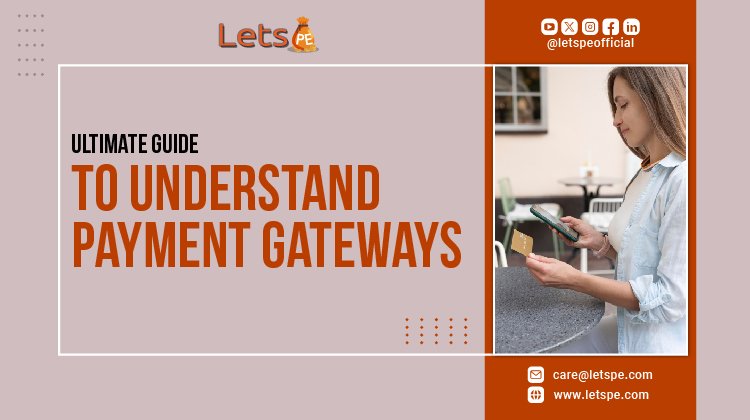The Ultimate Guide to Understand Payment Gateways

Understanding the world of online money transfer completely can be a little difficult to understand. The understanding of Payment Gateways is a must for each business or E-commerce company. Learn in depth from the ultimate guide to understand payment gateways given in this blog.
Register with LetsPe, a top Payment aggregator, to effortlessly handle all your business online payment transactions.
Guide to Understand Payment Gateways
Payment gateways mostly deal with online payments. Their basic work is to make these online transactions secure. If you own a business, whether it is new or established, you will require a payment gateway service provider.
Before moving ahead with Payment gateway meaning, its requirement for a business & other details, you should understand how the online money transfer process works.
Online Money Transaction Process
Online money transactions seem simple from the surface, but it is supported by a number of mediators and organizations. These mediators and companies act as a link between the payer and the payee.
Banks, Payment Gateway solutions, Merchant Payment alternatives, Aggregators (who are not banks), Technology service providers that enable payment gateway operations, and E-commerce marketplaces may all be included on the list of mediators.
These mentioned mediators help to process the online payments online.
Individuals Involved in this Procedure
In order to understand the online fund transaction processing, you must know about the individuals who are a part of this process.
Before we proceed ahead, you must know the following parts of online transaction processing:
The customer - Who owns the card and provided the data on the Payment page.
Customer's Bank (Issuing Bank) - That issued the customer's card.
Merchant - The person or corporation from whom the customer is purchasing a product or service (Payer).
The merchant's bank or acquiring bank.
The card network (e.g., Visa, Mastercard).
The payment gateway (software that makes the transactions secure).
Online Payment Process Steps
A complete step by step guide is given for the online payment process:
The buyer selects the product, clicks the pay button, and fills out the card details.
Payment Gateway carefully encrypts data and sends it to the Merchant's Bank.
The bank checks the card's balance and validity.
Bank Sends requests to the Card Network.
The card network passes the inquiry to the customer's bank, which confirms whether or not the payment should be executed.
The card network receives feedback from the customer's bank.
Card Network relays the feedback to the merchant's bank.
The Merchant's Bank notifies Payment Gateway about the payment, whether it was successful or not.
Two scenarios:
Payment successful: The Payment Gateway notifies the merchant, and the product/service is processed.
Payment Unsuccessful: Provides notification of payment failure.
Gives the ability to select any alternative payment option.
The whole procedure takes about three to four seconds to conclude.
Now, as you understand the very basics of online payment processing, let us begin with the fundamentals (What is a Payment Gateway?) and proceed to the advanced (Top Payment Gateway Service Provider).
What is a payment gateway and how does it work?
A software application that processes payment information (such as credit card details), sends it to the merchant's bank & then returns the feedback report.
A payment gateway is a merchant service provided by an e-commerce application service provider that enables e-commerce enterprises to accept credit cards and manage online payments.
How does a Payment Gateway Work?
The payment gateway is installed in the website or the app from which the payer buys the product or service.
Once the payer clicks on the payment gateway generated link that is pasted as a button on the platform, they are led to a payment page that is completely handled by the payment gateway providers.
The payment gateway company accepts the payment made on the individual merchant account and confirms the same to the merchant, i.e. payee.
This transferred amount is kept by the payment gateway organizations for some time and then transferred to the merchant after the deduction of the mutually pre decided charges.
Payment Gateway Charges- These charges are a specific percentage that is deducted from each transaction made. It may go up to 2% +GST.
Also Read: How to Choose the Right Payment Gateway for Your Business
Letspe payment gateway is a top payment gateway provider. You can connect with them today from their linkedIn account -MENTION IT.
Payment Gateway played the following roles in this process:
Confirms the card's balance and validity.
Share card information in an encrypted format (very secure).
Types of Payment Gateways
Payment Gateways are basically divided into five types:
Hosted Payment Gateways
It is a third-party checkout system that directs visitors to the payment service provider's (PSP) page.
This means that the customer will leave the merchant's site to complete payment before returning to finish their purchase.
Self-Hosted Payment Gateways
This provides a faster checkout process because the transaction takes place fully on the merchant's site.
There is no payment redirection, allowing the retailer complete control over the payment process.
API Payment Gateways
This is the technical interface that enables software developers to integrate payment gateway services into their apps or websites.
In contrast, payment gateway integration is the process of connecting a website or app to a payment gateway via an application programming interface (API).
Mobile Payment Gateways
A mobile payment gateway is a feature that enables customers to make online transactions conducted via mobile apps.
Local Bank Integration
Local bank integration gateways direct clients to the payment gateway's (the bank's) web page, where they enter their payment and contact information.
After completing the payment, the payer is redirected to the merchant's site, and payment notification information is sent.
Advantages of Using a Payment Gateway
Payment gateways are secure because they employ security measures and encryption like SSL, tokenization, and data encryption to protect sensitive data such as credit card details during transactions.
Utilizing a payment gateway provides many advantages to both the payer and the payee. Here are some key advantages:
Secured transactions.
Customer confidence.
International transactions.
There are multiple payment alternatives.
Transactions move faster.
E-commerce integration.
Analytics and reporting.
Subscription-based enterprises.
Customer disputes and chargeback solutions.
Scalability and business expansion.
The Best Payment Gateway Providers
The selection of the payment gateway depends on the requirement of the merchant and their business. Various factors that affect the choice of the merchant are:
Transaction fees, Security measures, Compatibility with E-commerce platform and the type of payments accepted.
Also Read: Understanding Payment Gateway Fees: What You Need to Know
Payment gateways take charges to cover all costs associated with the processing of payments, such as security, fraud protection, and support for customers.
Are there any disadvantages of the payment gateways?
Disadvantages may include transaction costs, chargebacks, technological flaws, and security threats if not properly handled.
If a payment gateway is aware of all the requirements for processing an online transaction, it may not encounter the previously mentioned disadvantages.
Payment Gateway Charges
The median charges vary substantially, but the majority of gateways apply a fee per transaction, which typically ranges between 0.3% and 3.5% +GST.
Payment Gateway of India - Letspe Payment Gateway
The Payment Gateway Service is provided by multiple companies at present in India. Letspe Payment Gateway is one such organization that deals with merchants and helps them in making their online transactions hassle-free and secure.
How do I set up a Payment Gateway?
Connecting a payment gateway with a website typically involves signing up for the service, connecting it with your website or sales platform, and adhering to any regulatory restrictions.
You can set up a payment gateway for your business by following the steps below:
Choose the payment gateway that is most appropriate for your business.
Connect with them and discuss your needs.
Once sorted, begin the onboarding process, which requires you to share some basic papers.
Once the gateway has approved your request, they will send you login credentials and an integration kit.
You can use these credentials to log into the merchant dashboard.
You can install this integration kit with the assistance of a software developer.
The payment link will now be live as a button on your website, app, or both.
The payment gateway connection is now online, and it will handle all of your business transactions.
Payment Gateway for a Website
Letspe is the leading payment gateway that has:
No Setup or Annual Charges.
Minimum service Charges - Up to 2% + GST only.
Multiple Payment Options - Debit card, credit card, phone payment, google.
payment, net banking, amazon pay, paytm, and nearly all other methods.
Minimum Onboarding Time - 24 hours to maximum 3 working days.
Integration with Ecommerce Platform.
Weekend Settlements.
Conclusion
In the blog above, we published The Ultimate Guide to Understanding Payment Gateways. Go through it and understand everything about Payment Gateways, how it processes, its types & top payment gateway service provider.
You may connect with Letspe today to incorporate a payment gateway solution into your business and win the trust of your customers.

 letspe_admin
letspe_admin 










